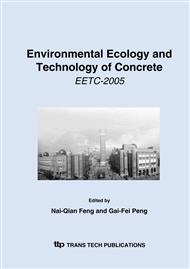p.567
p.572
p.584
p.591
p.595
p.603
p.610
p.618
p.624
Analysis of the Factors Affecting Crack Resistance of Dam Concrete
Abstract:
Crack prevention is still a main consideration in dam concrete technology. This paper summarizes the author's understanding about the factors affecting cracking-resistance of dam concrete, such as cold shrinkage, drying shrinkage, autogenous volume deformation and tensile strain capacity, etc. The tensile strain capacity is an important parameter in evaluating crack resistance of dam concrete. Reducing volume shrinkages and decreasing adiabatic rise of temperature are the effective measures for enhancing crack resistance of dam concrete, rather than raising the tensile strain capacity impractically especially by increasing cement content of concrete excessively.
Info:
Periodical:
Pages:
595-602
Citation:
Online since:
January 2006
Authors:
Price:
Сopyright:
© 2006 Trans Tech Publications Ltd. All Rights Reserved
Share:
Citation:


